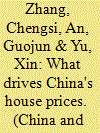| Srl | Item |
| 1 |
ID:
110394


|
|
|
|
|
| Publication |
2011.
|
| Summary/Abstract |
Recently, China has implemented many policy measures to control the oil demand of on-road vehicles. In 2010, China started to report the fuel consumption rates of light-duty vehicles tested in laboratory and to require new vehicles to show the rates on window labels. In this study, we examined the differences between the test and real-world fuel consumption of Chinese passenger cars by using the data reported by real-world drivers on the internet voluntarily. The sales-weighted average fuel consumption of new cars in China in 2009 was 7.80 L/100 km in laboratory and 9.02 L/100 km in real-world, representing a difference of 15.5%. For the 153 individual car models examined, the real-world fuel consumption rates were -8 to 60% different from the test values. The simulation results of the International Vehicle Emission model show that the real-world driving cycles in 22 selected Chinese cities could result in -8 to 34% of changes in fuel consumption compared to the laboratory driving cycle. Further government effort on fuel consumption estimates adjustment, local driving cycle development, and real-world data accumulation through communication with the public is needed to improve the accuracy of the labeling policy.
|
|
|
|
|
|
|
|
|
|
|
|
|
|
|
|
| 2 |
ID:
113691


|
|
|
|
|
| Publication |
2012.
|
| Summary/Abstract |
The high and rising house prices in China are not adequately accounted for the traditional explanations emphasizing demand-driven or cost-push factors. Recent published studies claim that gender imbalance increases competition among men in the marriage market, which has pushed Chinese, especially parents with a son, to buy houses as a signal of relative status in the marriage market; this marriage competition then causes high demand for houses and eventually leads to rising house prices in China. Empirical results in this paper, however, provide little support for this hypothesis and we find that a rise in the sex ratios for most age cohorts accounts for very small percentage variations in house price movements in China during 1998-2009. Further investigation suggests that excess demand driven by high monetary growth was a significant cause of the rising house prices in China during 1998-2009. Therefore, the impact of gender imbalance on house prices should not be exaggerated and monetary dynamics remains an important leading indicator for house price movements in China.
|
|
|
|
|
|
|
|
|
|
|
|
|
|
|
|